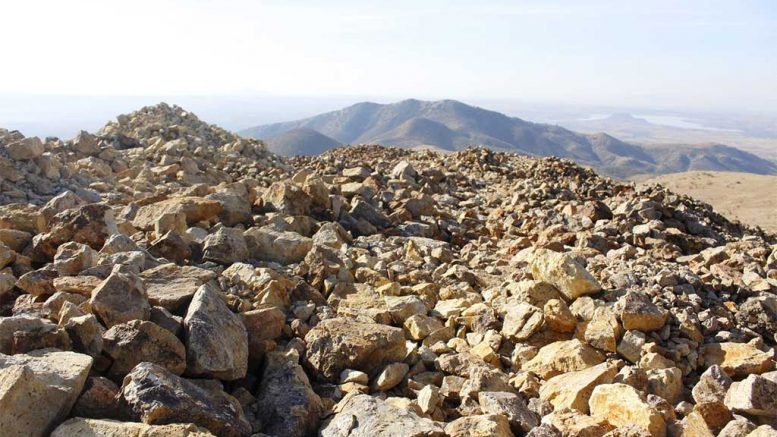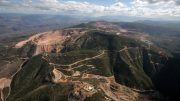Vangold Mining (TSXV: VAN; US-OTC: VGLDF) hopes to reactivate production at the historic El Pinguico gold mine, which operated more than a hundred years ago outside Guanajuato City, Mexico.
The mine — 2.5 km from Fresnillo’s (LON: FRES) Las Torres mine and 4.5 km from Endeavour Silver’s (TSX: EDR) El Cubo mine — produced gold and silver between 1906 and 1913, before it was shut down due to local and regional unrest during the Mexican Revolution (1910–1920).
Cameron King, a chemical engineer and former investment banker, and now president and CEO, plans to generate cash flow by processing metal from two leftover stockpiles — one at surface and the other underground — before kicking off a drill program that will look for mineralization that he says sits below the mine’s old workings and across the broader land package.
Vangold plans to produce ore from the surface stockpile from May 2018 until April 2019, and from the underground stockpile (which sits at 145 metres below surface) from February 2019 until March 2021.
King says the company will start mining the surface stockpile, while driving a decline down to access the underground stockpile.
“There is a lot of cash in these rocks,” King says. “The miners were only mining ore that was 15 equivalent grams gold per tonne. The cut-off grade was 15 grams because gold at the time was US$20 per oz., and so anything below that grade was uneconomic.”

Vangold Mining president and CEO Cameron King (far left) with colleagues at the historic El Pinguico gold mine in Mexico. Credit: Vangold Mining.
King says the underground stockpile contains 500,000 tonnes of high-grade ore that was never mucked out and still sits at the bottom of the stopes, while the surface stockpile contains 200,000 tonnes of lower-grade ore anywhere from 2 equivalent grams gold per tonne to 4 grams gold equivalent per tonne.
Back-of-the-envelope calculations at the current gold price puts the value of the underground stockpile, he says, at US$160 million, and the surface stockpile at US$8 million to $10 million.
“Shrinkage mining techniques were used in mining the veins, leaving large, open stopes,” King says. “This mining method allows for a quicker pace than mucking and milling — hence the large deposit of ore still in the mine.”
Mining companies active in the area could help Vangold on the processing side, King notes, until it builds a mill of its own. “We have full infrastructure, water, power and milling capacity all around us.”
King hopes Vangold can produce as early as March 2021 from the 8 level — or the bottom of the underground stockpile. The company could spend up to $2.5 million on a drill program in the first quarter of next year. Vangold attracted $1.5 million in an equity raise earlier this year and expects another financing this year. It will also look for $7 million to $10 million via offtake or streaming deals, he adds.
“We want to get an inferred resource targeting the lower Pinguico extension,” he says. “We will drill underneath the underground stockpile, which we call ‘de-risked’ because we know the vein dip and width. What we don’t know is how far it continues. Our estimation is that it could extend 600 to 800 metres.”
Vangold has completed a surface land agreement that helps permitting. A preliminary economic assessment will follow the drill program.
King says he stumbled upon Pinguico from September to October last year while doing due diligence on other properties in the area, including Patito, which Vangold now owns.
“I was on Patito and saw a bunch of oxide ore sitting on surface that covered 1 sq. km of mountainside, so I went over and took some samples,” he recalls. “I ran into the night guard who was protecting the old mine, and arranged to meet the owner, Mr. Ramirez, the next morning. We walked 500 metres into the mine and came across the underground ore stockpile, which continued another 500 metres.”
King says it took him two and a half months to negotiate a deal with the Ramirez family, which has owned the land for more than a century. Under the agreement, Vangold will pay Ramirez a 4% net smelter return royalty, plus 15% of the revenue generated from the stockpiles. All new production comes at a 3% royalty.
“The family had been approached over the years by Canadian companies and U.S. companies, but they never got the right deal,” King says. “They have had situations where they were lied to and nothing happened. They wanted a group to come in and do something — put some money into it. We’ve put more work and money into it than anyone else has in the last 100 years, and we are on the fast track to production.”
King targeted Mexico and the area around Guanajuato because of its rich mining history.
“I had a short checklist — I wanted to go to an area with a highly skilled labour force, where I can access engineers and infrastructure, and everything else I need to put a mine into operation, and Mexico was at the top of the list,” he says, adding that the Guanajuato area “was the birthplace” of mining in Mexico.
“The Spaniards found outcropping silver veins in the 1550s, including the Veta Madre — or the ‘mother vein’ — that supported Valenciana, the largest silver-producing mine in Mexico,” he says. “Valenciana operated for 350 years and at the time provided 25% of the world’s silver. The Valenciana mine and El Pinguico are on the same epithermal vein system. The Veda Madre is the main structure throughout the area and El Pinguico is 11 km from Valenciana through the city of Guanajuato, and up the mountain road to the town of Calderones.”
King notes that not only is the mineralization in this part of Mexico “incredible,” but it is also a low-risk area, and the project is a 20-minute drive from the company’s office in Guanajuato city.
“We’re close to universities and government offices. It’s very, very safe. Guanajuato is a UNESCO heritage city. It’s beautiful. It’s where Mexicans go to holiday. It’s a religious area, and the culture is pro-mining.”
King points out that he has been travelling to Guanajuato for the last year and feels comfortable there. “The people are friendly. It’s a tourist town. It’s a manufacturing area and the centre of all the automobile plants, so it has a nice, developing middle class. People tend to be wealthier than in some of the other regions of the country.”






Be the first to comment on "Vangold to mine historic stockpiles at El Pinguico"